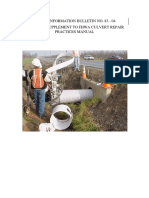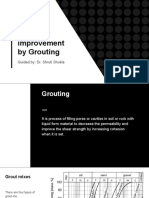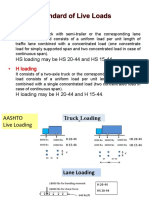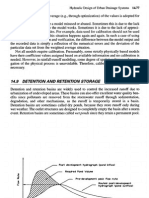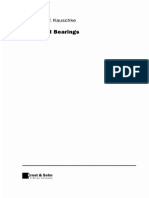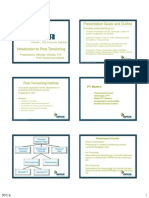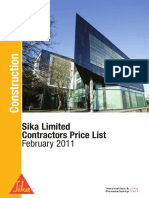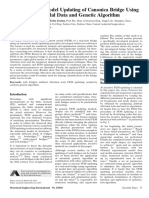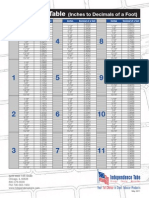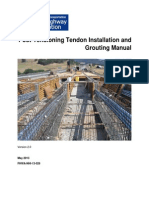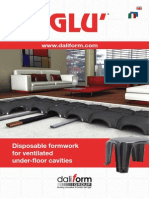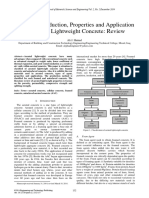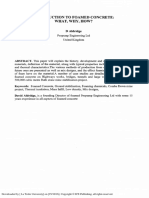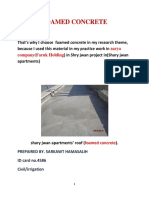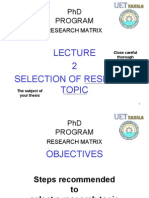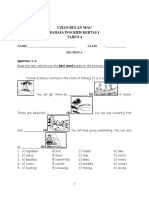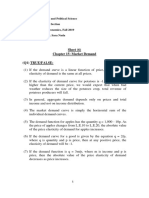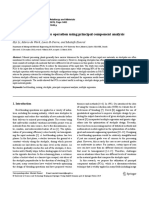MATEC Web of Conferences 97, 01097 (2017) DOI: 10.
1051/ matecconf/20179701097
ETIC 2016
Applications of Foamed Lightweight Concrete
Kamarul Aini Mohd Sari1,*, and Abdul Rahim Mohammed Sani2
1,2
Faculty of Engineering Technology, Universiti Tun Hussein Onn Malaysia, 86400 Batu Pahat,
Johor.
Abstract. Application of foamed concrete is increasing at present due to
high demand on foamed concrete structures with good mechanical and
physical properties. This paper discusses on the use of basic raw materials,
their characteristics, production process, and their application in foamed
lightweight concrete with densities between 300 kg/m3 and 1800 kg/m3. It
also discusses the factors that influence the strengths and weaknesses of
foamed concrete based on studies that were conducted previously.
1 Introduction
The introduction of polymers into cementitious materials to improve the bond adhesion,
flexibility and workability of resultant composite was first made in the 1930s with natural
rubber. However, the main difficulty encountered when using this natural polymer material
is the inability to alter the chemical structure and tailor the physical properties to those
required for a particular application (Miller 2005).
The primary reason for introducing polymer materials into concrete and cement-based
compounds is to improve the physical and mechanical characteristics of the resultant
cementitious material to be lightweight, self compacting, high workability, good thermal
insulation, and can be cut and nail/screw easily (Koh 2008). One of the important
characteristics of lightweight concrete is light or low-density foamed. El-Reedy, 2009 has
state the classification of lightweight concrete in Fig. 1.
Foamed concrete is formed when air-voids are entrapped in mortar by suitable foaming
agent. It possesses high flow ability, low self-weight, minimal consumption of aggregate,
controlled low strength and excellent thermal insulation properties. Foamed concrete with
densities between 400 kg/m3 and 1600 kg/m3 is obtained for the purpose of structural,
partition, insulation, and filling grades (Ramamurthy 2009).
An improvement in the workability and bond adhesion will also increase the flexural
and tensile strength. Polymer modified cementitious materials also showed an increase in
durability and water resistance. Hence, the addition of the polymer into cementitious
system enabled its use in more complex structures and situations (Ohama 1998) .
*
Corresponding author: aini@uthm.edu.my
© The Authors, published by EDP Sciences. This is an open access article distributed under the terms of the
Creative Commons Attribution License 4.0 (http://creativecommons.org/licenses/by/4.0/).
�MATEC Web of Conferences 97, 01097 (2017) DOI: 10.1051/ matecconf/20179701097
ETIC 2016
Fig. 1. Classification of lightweight concrete.
No-fines Concrete Lightweight Aggregate Aerated Concrete
Concrete Chemical Foaming
Mixture
Gravel Clinker Aluminium powder Performed foam
Crushed stone Foamed slag Hydrogen peroxide Air-entrained
and bleaching foam
powder
Coarse clinker Expanded clay
Sintered pulverized fuel Expanded shale
ash
Expanded clay or shale Expanded slate
Expanded slate Sintered pulverized fuel
ash
Foamed slag Exfoliated vermiculite
Expanded perlite
Pumice
Organic aggregate
The initial use of polymers in concrete systems is achieved using a liquid additive,
which was added to the cementitious material during mixing. However, in certain
circumstances it has become more advantageous nowadays to include the polymer in the
actual cementitious powder, which polymerizes when in contact with water during the
mixing process. This allows the quantity of polymer throughout the mix to be controlled
more precisely, reducing the errors associated with the mixing of the dispersion directly
with the cement-based product. This can have the advantage of lowering the cost of
manufacturing and construction process.
2 Materials and method
2.1 Materials
Main materials to produce foam concrete are mortar or cement grout and foam. Mortar is
normally fresh concrete which contains a mix of cement, fine sand and water. Additional
mix is foam protein-based or synthetic to reduce the weight of the concrete. Hydrolyzed
proteins have higher strength performance, while synthetic based foaming agents are easier
to handle, cheaper and requires less energy and can be stored longer.
2.2 Production methods
Foaming admixtures is based on BS8443:2005. Barnes 2009 and Ramamurthy 2009
discussed the method of producing foam, known as the wet method and the dry method.
(i) Wet foam has a large loose bubble structure. Although stable, is not recommended for
the production of foamed concretes with densities below 1000 kg/m3. It involves
spraying a solution of the agent and water over a fine mesh, leading to a foam with
bubbles of size between 2 mm and 5 mm.
(ii) Dry foam is extremely stable. Stability is a characteristic that has become increasingly
important as the density of the foamed concrete reduces. It is produced by forcing a
solution of foaming agent and water through restrictions whilst forcing compressed air
2
�MATEC Web of Conferences 97, 01097 (2017) DOI: 10.1051/ matecconf/20179701097
ETIC 2016
into the mixing chamber. The resulting bubble size is smaller than wet foam, i.e. less
than 1 mm in diameter.
After the foam is stable, it can be mixed into the concrete using two method (Barnes 2009),
i.e. the inline or pre-foam methods.
2.1.1 Inline
Cement, fine sand and water are placed into a unit where they are blended together with the
foam. The mixing process is more controlled and greater quantities can be easily produced.
There are two types of processes, depending on whether the wet method or dry method is
used.
In wet method, the base materials are the same as those used in the pre-foam system,
but are generally wetter. The base material and the foam are fed through a series of static
inline mixers where the two are mixed together. The foam and the base materials are
blended together and continuously monitored by an on-board density monitor. The output
volume is not governed by the size of the pre-mix concrete truck, but by the density of the
foamed concrete, where one 8 m3 delivery of base material can produce 35 m3 of a 500
kg/m3 foamed concrete.
2.1.2 Pre-foam
In pre-foam method, pre-mix concrete truck delivers the base materials to site and then the
pre-formed foam is injected directly into the back of the truck whilst the mixer is rotating.
The advantage of this method is that, relatively small quantities can be ordered. However, it
does rely on the mixing action of the concrete truck. Densities in the range of 300 kg/m3 to
1200 kg/m3 can be achieved. Typically foamed air in this method is in the range of 20% to
60% of air.
3 Properties
Ramamurthy, 2009 listed types of foam concrete properties as:
(i) fresh state properties to be familiar with the consistency and stability,
(ii) physical properties to recognize the drying shrinkage, air-void system and density,
(iii) mechanical properties to identify the compressive strength, flexural and tensile
strengths, and modulus of elasticity,
(iv) thermal properties to classify the thermal conductivity, thermal expansion, specific
heat, and flammability,
(v) strength prediction models,
(vi) durability of foamed concrete such as permeation characteristics, and resistance to
aggressive environment, and
(vii) functional characteristics for instance thermal insulation, acoustical properties, and
fire resistance.
Table 1 summarizes the applications of foamed concrete based on its density
(Aldridge 2005, Liew 2005, Jones 2005, Barnes 2009). Common density of foamed
concrete to be developed is between 1000 kg/m3 to 1500 kg/m3, which generally is used for
housing applications, prefabrications and cast-in place wall, either load bearing or non-load
bearing structures.
3
�MATEC Web of Conferences 97, 01097 (2017) DOI: 10.1051/ matecconf/20179701097
ETIC 2016
Table 1. Summary of foamed concrete applications based on density
Density (kg/m3) Application
300-600 Replacement of existing soil, soil stabilization, raft foundation.
Currently being used to stabilize a redundant, geotechnical
500-600
rehabilitation and soil settlement. Road construction.
Widely used in void filling, as an alternative to granular fill. Some
600-800 such applications include filling of old sewerage pipes, wells,
basement and subways.
Primarily used in production of blocks and other non-load bearing
800 - 900
building element such as balcony railing, partitions, parapets, etc.
Used in prefabrication and cast-in place wall, either load bearing or
1100-1400
non-load bearing and floor screeds.
1100-1500 Housing applications.
Recommended for slabs and other load bearing building element
1600-1800
where higher strength required.
Apart from the density of the aggregates, the density of the concrete also depends on the
grading of the aggregates, their moisture content, mix proportions, cement content, water to
binder ratio, and chemical and mineral admixtures. Besides characteristics of the materials,
it also depends upon the method of mixing, compaction, and curing condition (Osman Unal
2007).
Barnes (2009) reported that there is a correlation between the density and
compressive strength of foamed concrete. Comparing the wet density of the foamed
concrete at the point of discharge, with the wet density determined during development
testing gives an estimate of likely strength at a given age.
The cellular structure of foamed concrete contributes to good thermal insulating
properties and low thermal conductivity values. Table 2 shows that the thermal
conductivity of foamed concrete ranges between 0.1 W/mK and 0.7 W/mK for dry densities
of 600 kg/m3 to 1600 kg/m3. These thermal conductivities of foamed concrete are typically
5% to 30% of those measured on normal weight concrete. Thermal conductivities reduces
with decreasing densities.
Table 2. Typical properties of foamed concrete based on British Concrete Association (BCA)
Dry Compressive Thermal Modulus of Drying
Density strength (N/mm2) Conductivity Elasticity Shrinkage (%)
(kg/m3) (W/mK) (kN/mm2)
400 0.5 – 1.0 0.10 0.8 – 1.0 0.30 – 0.35
600 1.0 – 1.5 0.11 1.0 – 1.5 0.22 – 0.25
800 1.5 – 2.0 0.17 – 0.23 2.0 – 2.5 0.20 – 0.22
1000 2.5 – 3.0 0.23 – 0.30 2.5 – 3.0 0.15 – 0.18
1200 4.5 – 5.5 0.38 – 0.42 3.5 – 4.0 0.09 – 0.11
1400 6.0 – 8.0 0.50 – 0.55 5.0 – 6.0 0.07 – 0.09
1600 7.5 – 10.0 0.62 – 0.66 10.0 – 12.0 0.06 – 0.07
Foamed concrete depends on its many characteristics for its different applications in
building construction. These are some guidelines on production and processes to produce
the best foamed concrete.
The strength of foamed concrete are increase by :
(i) decreasing porosity (less foam),
(ii) using finer sand, less than 5 mm (Nambiar 2006),
(iii) introducing small air bubbles (between 0.1 mm and 1.5 mm) with uniform
distribution (Brady 2001, Kunhanandan Nambiar 2006),
4
�MATEC Web of Conferences 97, 01097 (2017) DOI: 10.1051/ matecconf/20179701097
ETIC 2016
(iv) using fly ash and silica fume for pozolanic reaction,
(v) air curing (compared to sealed/ water curing) (Kearsley 1998,), and
(vi) usage of polypropylene.
4 Conclusions
Applications and properties of foamed lightweight concrete have been discussed in this
paper. In extension of this paper, the production of lightweight concrete for insulation
purposes with target density below 1500 kg/m3 will be carried out. The natural material
considered is the palm kernel oil-based polyurethane, which will be mixed with concrete
for the production of building materials converging on wall provisions.
References
1. D. Aldridge, Introduction to Foamed Concrete: What, Why and How? Use of Foamed
Concrete in Construction (Thomas Telford Publishing, UK, 2005)
2. Information on
https://www.thenbs.com/PublicationIndex/documents/details?Pub=BCA&DocId
3. R.A. Barnes, Foamed Concrete: Application and spesification. Excellence in Concrete
Construction through Innovation (Taylor & Francis Group, London, 2009)
4. E.K. Kunhanandan, K.R. Nambiar, Cement Concrete Comp., 28, 475 (2006)
5. M.A.E. Reedy, Advance materials and techniques for reinfoorced concrete structure
(Taylor and Francis Group, Egypt, 2009)
6. H.B. Koh, Y.L. Lee, Foamed Concrete - A Potential Civil Engineering Materials
(UniMAP, Perlis, 2008)
7. K.C. Brady, M.R. Jones, Specification for Foamed Concrete (Highway Agency, UK,
2001)
8. K. Ramamurthy, E.K.K. Nambiar, G.I.S. Ranjani, Cement Concrete Comp., 31, 388
(2009)
9. E.P. Kearsley, P. Booysens, Concrete Beton, 91, 9 (1998)
10. A. Liew, New Innovaative Lightweight Foam Concrete Technology. Use of Foamed
Concrete in Construction (Thomas Telford Publishing, UK, 2005)
11. M.R. Jones, A. McCarthy. Behaviour and Assessment of Foamed Concrete for
Construction Applications. Use of Foamed Concrete in Construction (Thomas Telford
Publishing, UK, 2005)
12. M. Miller, Polymers in Cementitious Materials (Rapra Technology Limited, UK,
2005)
13. Y. Ohama, Cement Concrete Comp., 20, 189 (1998)
14. Osman Unal, T. Uygunoglu, A. Yildiz, Build. Environ., 42, 584 (2007)
